Abstract
Epidemiologic and occupational studies indicate adverse health effects due to inhalation of particulate air pollutants, but precise biologic mechanisms responsible have yet to be fully established. The tracheobronchial epithelium forms the body's first physiologic barrier to such airborne pollutants, where ciliary movement functions to remove the offending substances caught in the overlying mucus layer. Resident and infiltrating phagocytic cells also function in this removal process. In this paper, we examine the role of reactive oxygen and nitrogen species (ROS/RNS) in the response of airway epithelium to particulates. Some particulates themselves can generate ROS, as can the epithelial cells, in response to appropriate stimulation. In addition, resident macrophages in the airways and the alveolar spaces can release ROS/RNS after phagocytosis of inhaled particles. These macrophages also release large amounts of tumor necrosis factor alpha (TNF-alpha), a cytokine that can generate responses within the airway epithelium dependent upon intracellular generation of ROS/RNS. As a result, signal transduction pathways are set in motion that may contribute to inflammation and other pathobiology in the airway. Such effects include increased expression of intercellular adhesion molecule 1, interleukin-6, cytosolic and inducible nitric oxide synthase, manganese superoxide dismutase, cytosolic phospholipase A2, and hypersecretion of mucus. Ultimately, ROS/RNS may play a role in the global response of the airway epithelium to particulate pollutants via activation of kinases and transcription factors common to many response genes. Thus, defense mechanisms involved in responding to offending particulates may result in a complex cascade of events that can contribute to airway pathology.
Full text
PDF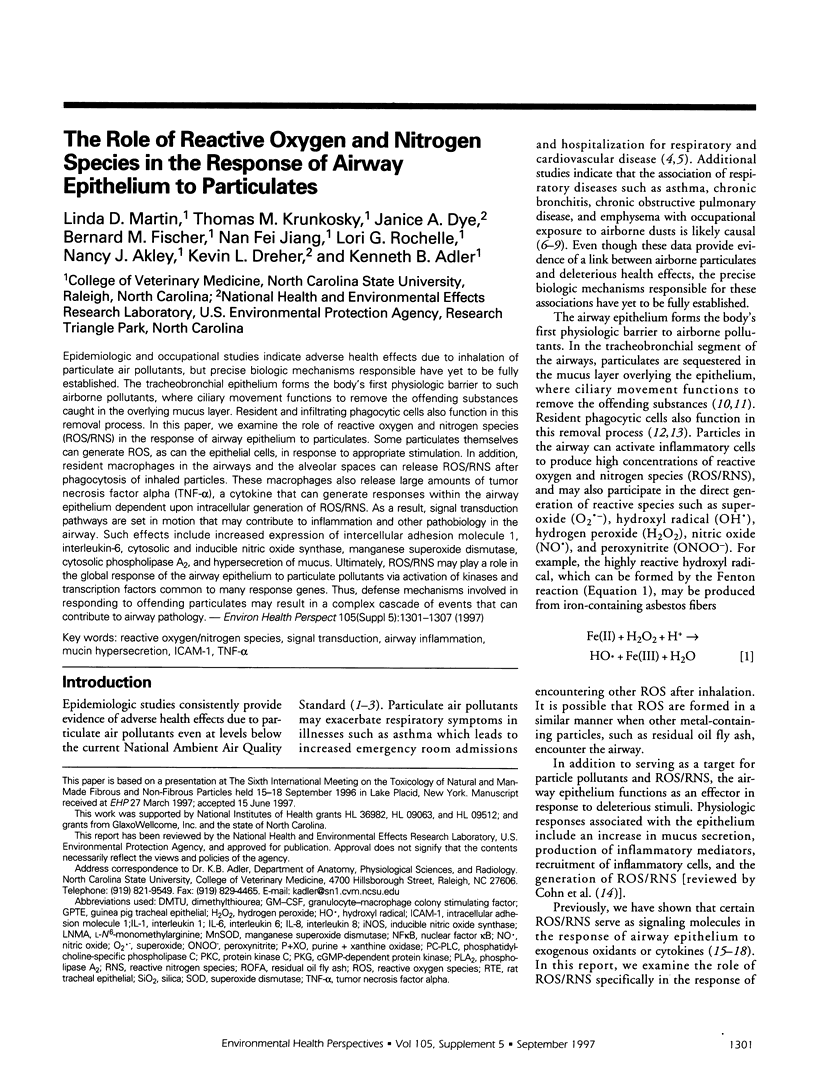
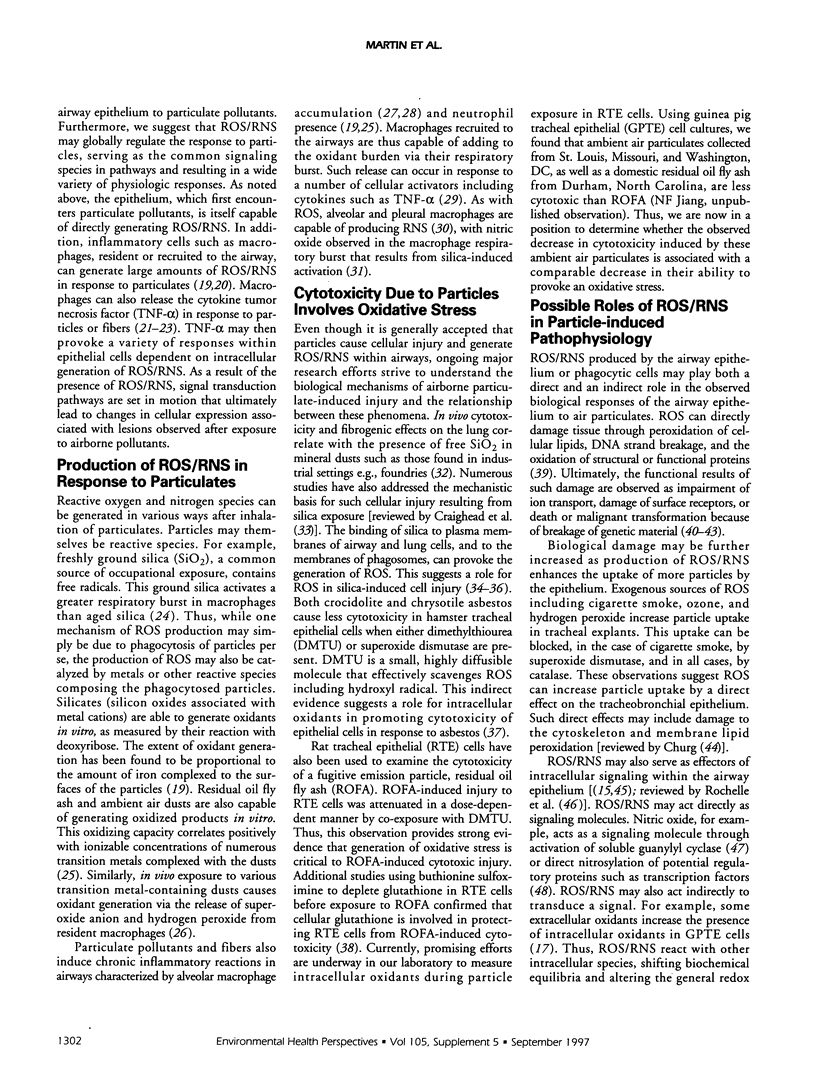
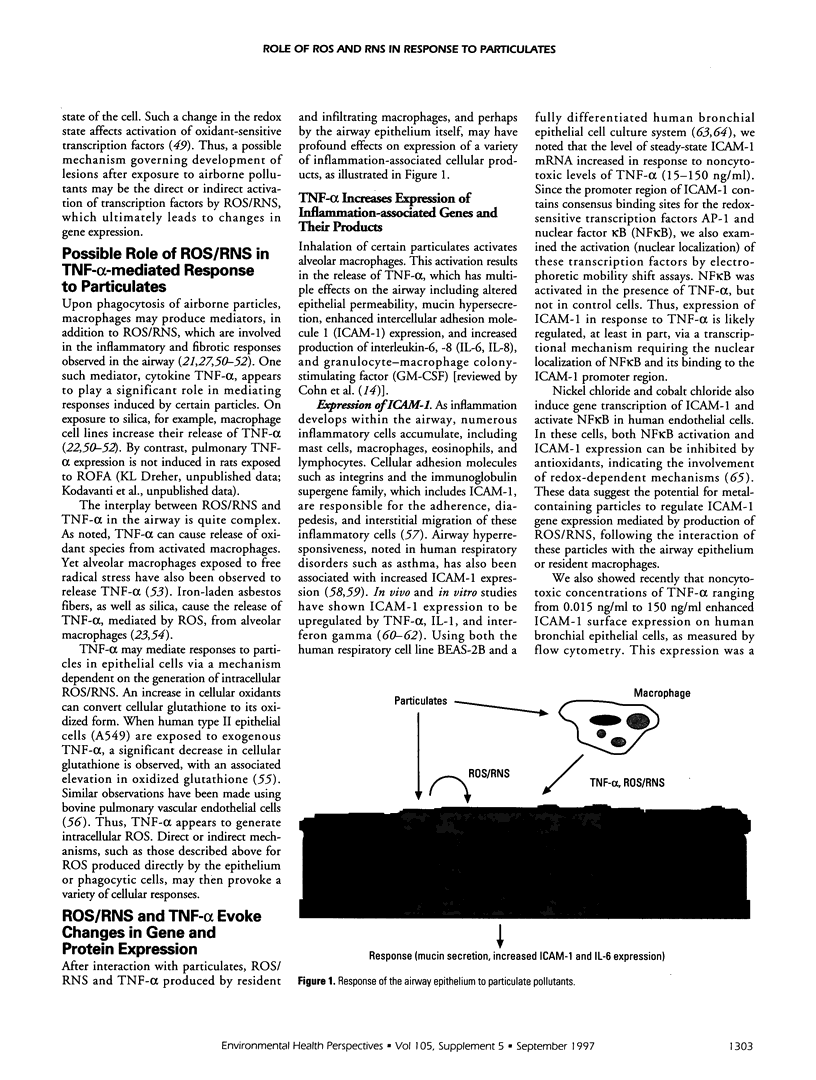

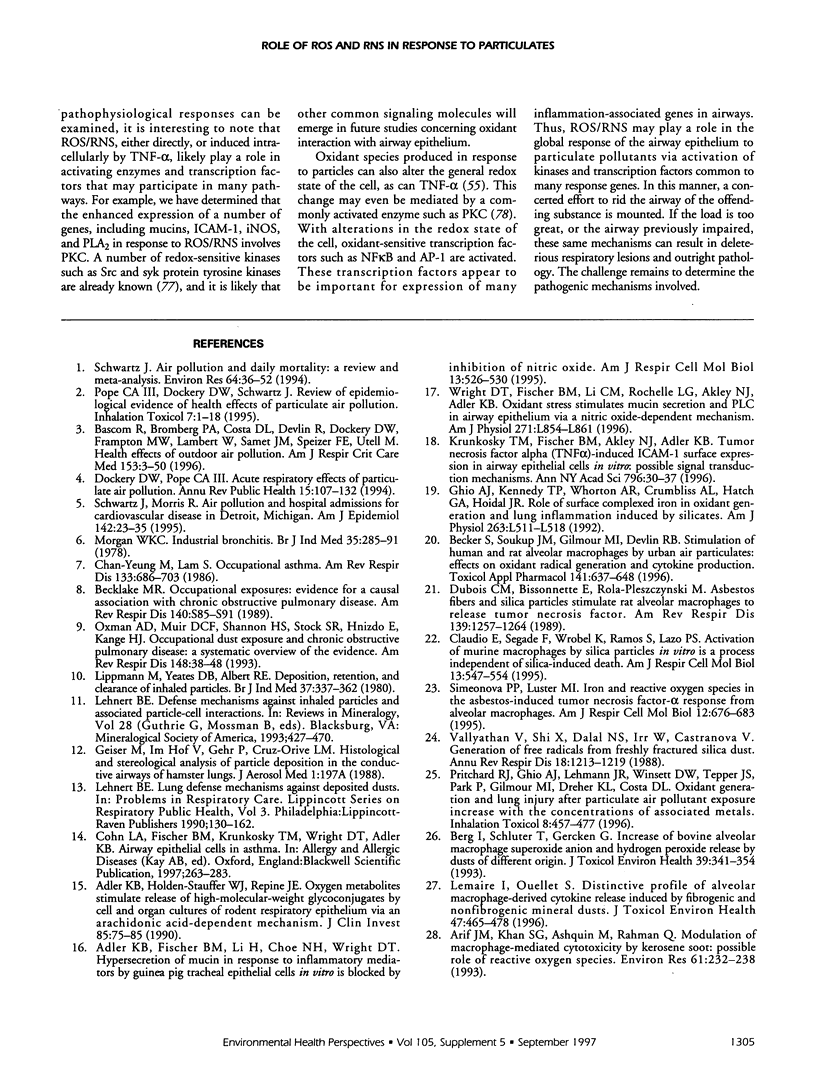
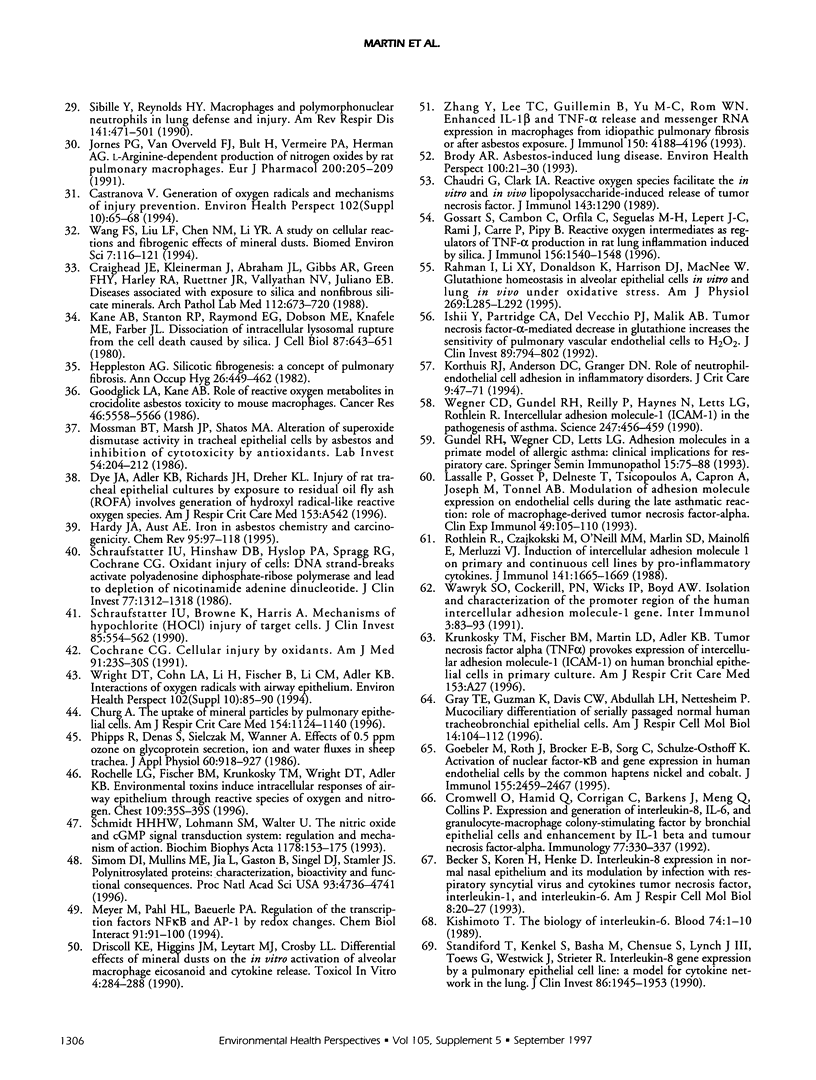
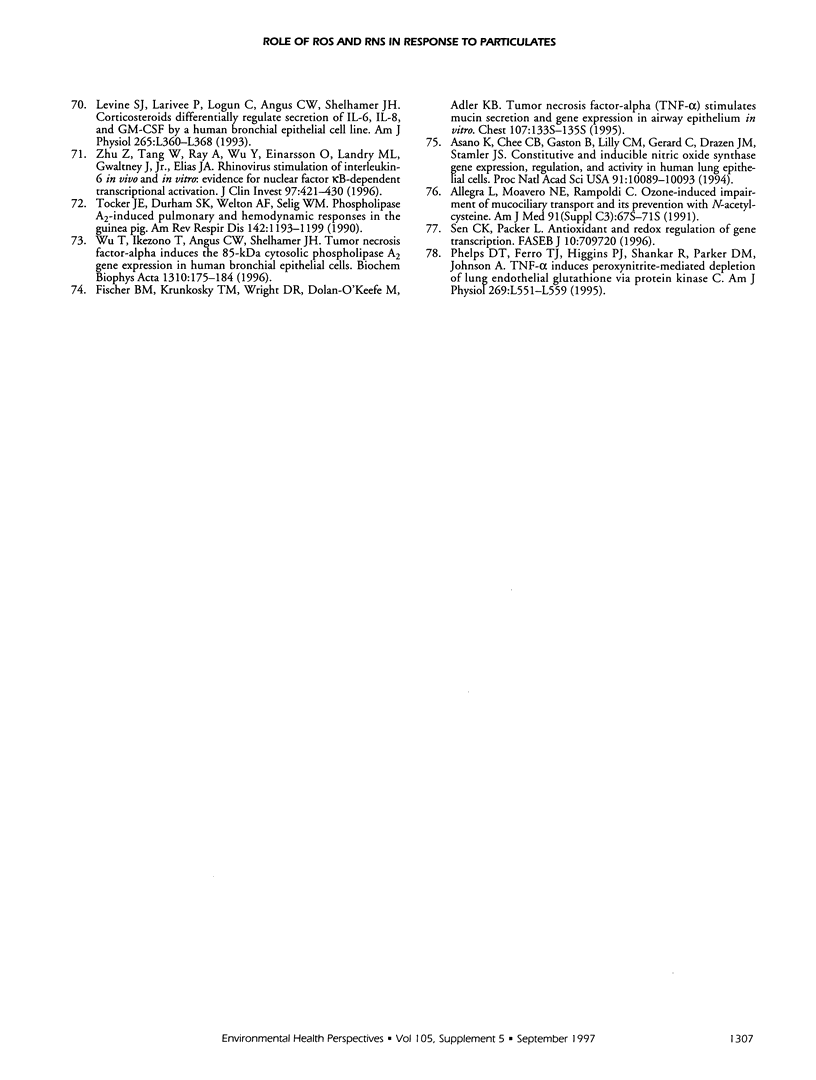
Selected References
These references are in PubMed. This may not be the complete list of references from this article.
- Adler K. B., Fischer B. M., Li H., Choe N. H., Wright D. T. Hypersecretion of mucin in response to inflammatory mediators by guinea pig tracheal epithelial cells in vitro is blocked by inhibition of nitric oxide synthase. Am J Respir Cell Mol Biol. 1995 Nov;13(5):526–530. doi: 10.1165/ajrcmb.13.5.7576687. [DOI] [PubMed] [Google Scholar]
- Adler K. B., Holden-Stauffer W. J., Repine J. E. Oxygen metabolites stimulate release of high-molecular-weight glycoconjugates by cell and organ cultures of rodent respiratory epithelium via an arachidonic acid-dependent mechanism. J Clin Invest. 1990 Jan;85(1):75–85. doi: 10.1172/JCI114436. [DOI] [PMC free article] [PubMed] [Google Scholar]
- Arif J. M., Khan S. G., Ashquin M., Rahman Q. Modulation of macrophage-mediated cytotoxicity by kerosene soot: possible role of reactive oxygen species. Environ Res. 1993 May;61(2):232–238. doi: 10.1006/enrs.1993.1067. [DOI] [PubMed] [Google Scholar]
- Asano K., Chee C. B., Gaston B., Lilly C. M., Gerard C., Drazen J. M., Stamler J. S. Constitutive and inducible nitric oxide synthase gene expression, regulation, and activity in human lung epithelial cells. Proc Natl Acad Sci U S A. 1994 Oct 11;91(21):10089–10093. doi: 10.1073/pnas.91.21.10089. [DOI] [PMC free article] [PubMed] [Google Scholar]
- Becker S., Koren H. S., Henke D. C. Interleukin-8 expression in normal nasal epithelium and its modulation by infection with respiratory syncytial virus and cytokines tumor necrosis factor, interleukin-1, and interleukin-6. Am J Respir Cell Mol Biol. 1993 Jan;8(1):20–27. doi: 10.1165/ajrcmb/8.1.20. [DOI] [PubMed] [Google Scholar]
- Becker S., Soukup J. M., Gilmour M. I., Devlin R. B. Stimulation of human and rat alveolar macrophages by urban air particulates: effects on oxidant radical generation and cytokine production. Toxicol Appl Pharmacol. 1996 Dec;141(2):637–648. doi: 10.1006/taap.1996.0330. [DOI] [PubMed] [Google Scholar]
- Becklake M. R. Occupational exposures: evidence for a causal association with chronic obstructive pulmonary disease. Am Rev Respir Dis. 1989 Sep;140(3 Pt 2):S85–S91. doi: 10.1164/ajrccm/140.3_Pt_2.S85. [DOI] [PubMed] [Google Scholar]
- Berg I., Schlüter T., Gercken G. Increase of bovine alveolar macrophage superoxide anion and hydrogen peroxide release by dusts of different origin. J Toxicol Environ Health. 1993 Jul;39(3):341–354. doi: 10.1080/15287399309531756. [DOI] [PubMed] [Google Scholar]
- Brody A. R. Asbestos-induced lung disease. Environ Health Perspect. 1993 Apr;100:21–30. doi: 10.1289/ehp.9310021. [DOI] [PMC free article] [PubMed] [Google Scholar]
- Castranova V. Generation of oxygen radicals and mechanisms of injury prevention. Environ Health Perspect. 1994 Dec;102 (Suppl 10):65–68. doi: 10.1289/ehp.94102s1065. [DOI] [PMC free article] [PubMed] [Google Scholar]
- Chan-Yeung M., Lam S. Occupational asthma. Am Rev Respir Dis. 1986 Apr;133(4):686–703. doi: 10.1164/arrd.1986.133.4.686. [DOI] [PubMed] [Google Scholar]
- Chaudhri G., Clark I. A. Reactive oxygen species facilitate the in vitro and in vivo lipopolysaccharide-induced release of tumor necrosis factor. J Immunol. 1989 Aug 15;143(4):1290–1294. [PubMed] [Google Scholar]
- Churg A. The uptake of mineral particles by pulmonary epithelial cells. Am J Respir Crit Care Med. 1996 Oct;154(4 Pt 1):1124–1140. doi: 10.1164/ajrccm.154.4.8887617. [DOI] [PubMed] [Google Scholar]
- Claudio E., Segade F., Wróbel K., Ramos S., Lazo P. S. Activation of murine macrophages by silica particles in vitro is a process independent of silica-induced cell death. Am J Respir Cell Mol Biol. 1995 Nov;13(5):547–554. doi: 10.1165/ajrcmb.13.5.7576690. [DOI] [PubMed] [Google Scholar]
- Cochrane C. G. Cellular injury by oxidants. Am J Med. 1991 Sep 30;91(3C):23S–30S. doi: 10.1016/0002-9343(91)90280-b. [DOI] [PubMed] [Google Scholar]
- Cromwell O., Hamid Q., Corrigan C. J., Barkans J., Meng Q., Collins P. D., Kay A. B. Expression and generation of interleukin-8, IL-6 and granulocyte-macrophage colony-stimulating factor by bronchial epithelial cells and enhancement by IL-1 beta and tumour necrosis factor-alpha. Immunology. 1992 Nov;77(3):330–337. [PMC free article] [PubMed] [Google Scholar]
- Diseases associated with exposure to silica and nonfibrous silicate minerals. Silicosis and Silicate Disease Committee. Arch Pathol Lab Med. 1988 Jul;112(7):673–720. [PubMed] [Google Scholar]
- Dockery D. W., Pope C. A., 3rd Acute respiratory effects of particulate air pollution. Annu Rev Public Health. 1994;15:107–132. doi: 10.1146/annurev.pu.15.050194.000543. [DOI] [PubMed] [Google Scholar]
- Dubois C. M., Bissonnette E., Rola-Pleszczynski M. Asbestos fibers and silica particles stimulate rat alveolar macrophages to release tumor necrosis factor. Autoregulatory role of leukotriene B4. Am Rev Respir Dis. 1989 May;139(5):1257–1264. doi: 10.1164/ajrccm/139.5.1257. [DOI] [PubMed] [Google Scholar]
- Fischer B. M., Krunkosky T. M., Wright D. T., Dolan-O'Keefe M., Adler K. B. Tumor necrosis factor-alpha (TNF-alpha) stimulates mucin secretion and gene expression in airway epithelium in vitro. Chest. 1995 Mar;107(3 Suppl):133S–135S. doi: 10.1378/chest.107.3_supplement.133s. [DOI] [PubMed] [Google Scholar]
- Ghio A. J., Kennedy T. P., Whorton A. R., Crumbliss A. L., Hatch G. E., Hoidal J. R. Role of surface complexed iron in oxidant generation and lung inflammation induced by silicates. Am J Physiol. 1992 Nov;263(5 Pt 1):L511–L518. doi: 10.1152/ajplung.1992.263.5.L511. [DOI] [PubMed] [Google Scholar]
- Goebeler M., Roth J., Bröcker E. B., Sorg C., Schulze-Osthoff K. Activation of nuclear factor-kappa B and gene expression in human endothelial cells by the common haptens nickel and cobalt. J Immunol. 1995 Sep 1;155(5):2459–2467. [PubMed] [Google Scholar]
- Goodglick L. A., Kane A. B. Role of reactive oxygen metabolites in crocidolite asbestos toxicity to mouse macrophages. Cancer Res. 1986 Nov;46(11):5558–5566. [PubMed] [Google Scholar]
- Gossart S., Cambon C., Orfila C., Séguélas M. H., Lepert J. C., Rami J., Carré P., Pipy B. Reactive oxygen intermediates as regulators of TNF-alpha production in rat lung inflammation induced by silica. J Immunol. 1996 Feb 15;156(4):1540–1548. [PubMed] [Google Scholar]
- Gray T. E., Guzman K., Davis C. W., Abdullah L. H., Nettesheim P. Mucociliary differentiation of serially passaged normal human tracheobronchial epithelial cells. Am J Respir Cell Mol Biol. 1996 Jan;14(1):104–112. doi: 10.1165/ajrcmb.14.1.8534481. [DOI] [PubMed] [Google Scholar]
- Gundel R. H., Wegner C. D., Letts L. G. Adhesion molecules in a primate model of allergic asthma: clinical implications for respiratory care. Springer Semin Immunopathol. 1993;15(1):75–88. doi: 10.1007/BF00204627. [DOI] [PubMed] [Google Scholar]
- Health effects of outdoor air pollution. Committee of the Environmental and Occupational Health Assembly of the American Thoracic Society. Am J Respir Crit Care Med. 1996 Jan;153(1):3–50. doi: 10.1164/ajrccm.153.1.8542133. [DOI] [PubMed] [Google Scholar]
- Heppleston A. G. Silicotic fibrogenesis: a concept of pulmonary fibrosis. Ann Occup Hyg. 1982;26(1-4):449–462. [PubMed] [Google Scholar]
- Ishii Y., Partridge C. A., Del Vecchio P. J., Malik A. B. Tumor necrosis factor-alpha-mediated decrease in glutathione increases the sensitivity of pulmonary vascular endothelial cells to H2O2. J Clin Invest. 1992 Mar;89(3):794–802. doi: 10.1172/JCI115658. [DOI] [PMC free article] [PubMed] [Google Scholar]
- Jorens P. G., Van Overveld F. J., Bult H., Vermeire P. A., Herman A. G. L-arginine-dependent production of nitrogen oxides by rat pulmonary macrophages. Eur J Pharmacol. 1991 Aug 6;200(2-3):205–209. doi: 10.1016/0014-2999(91)90573-9. [DOI] [PubMed] [Google Scholar]
- Kane A. B., Stanton R. P., Raymond E. G., Dobson M. E., Knafelc M. E., Farber J. L. Dissociation of intracellular lysosomal rupture from the cell death caused by silica. J Cell Biol. 1980 Dec;87(3 Pt 1):643–651. doi: 10.1083/jcb.87.3.643. [DOI] [PMC free article] [PubMed] [Google Scholar]
- Kishimoto T. The biology of interleukin-6. Blood. 1989 Jul;74(1):1–10. [PubMed] [Google Scholar]
- Korthuis R. J., Anderson D. C., Granger D. N. Role of neutrophil-endothelial cell adhesion in inflammatory disorders. J Crit Care. 1994 Mar;9(1):47–71. doi: 10.1016/0883-9441(94)90032-9. [DOI] [PubMed] [Google Scholar]
- Krunkosky T. M., Fischer B. M., Akley N. J., Adler K. B. Tumor necrosis factor alpha (TNF alpha)-induced ICAM-1 surface expression in airway epithelial cells in vitro: possible signal transduction mechanisms. Ann N Y Acad Sci. 1996 Oct 31;796:30–37. doi: 10.1111/j.1749-6632.1996.tb32564.x. [DOI] [PubMed] [Google Scholar]
- Lassalle P., Gosset P., Delneste Y., Tsicopoulos A., Capron A., Joseph M., Tonnel A. B. Modulation of adhesion molecule expression on endothelial cells during the late asthmatic reaction: role of macrophage-derived tumour necrosis factor-alpha. Clin Exp Immunol. 1993 Oct;94(1):105–110. doi: 10.1111/j.1365-2249.1993.tb05985.x. [DOI] [PMC free article] [PubMed] [Google Scholar]
- Lemaire I., Ouellet S. Distinctive profile of alveolar macrophage-derived cytokine release induced by fibrogenic and nonfibrogenic mineral dusts. J Toxicol Environ Health. 1996 Apr 5;47(5):465–478. doi: 10.1080/009841096161618. [DOI] [PubMed] [Google Scholar]
- Levine S. J., Larivée P., Logun C., Angus C. W., Shelhamer J. H. Corticosteroids differentially regulate secretion of IL-6, IL-8, and G-CSF by a human bronchial epithelial cell line. Am J Physiol. 1993 Oct;265(4 Pt 1):L360–L368. doi: 10.1152/ajplung.1993.265.4.L360. [DOI] [PubMed] [Google Scholar]
- Lippmann M., Yeates D. B., Albert R. E. Deposition, retention, and clearance of inhaled particles. Br J Ind Med. 1980 Nov;37(4):337–362. doi: 10.1136/oem.37.4.337. [DOI] [PMC free article] [PubMed] [Google Scholar]
- Meyer M., Pahl H. L., Baeuerle P. A. Regulation of the transcription factors NF-kappa B and AP-1 by redox changes. Chem Biol Interact. 1994 Jun;91(2-3):91–100. doi: 10.1016/0009-2797(94)90029-9. [DOI] [PubMed] [Google Scholar]
- Morgan W. K. Industrial bronchitis. Br J Ind Med. 1978 Nov;35(4):285–291. doi: 10.1136/oem.35.4.285. [DOI] [PMC free article] [PubMed] [Google Scholar]
- Mossman B. T., Marsh J. P., Shatos M. A. Alteration of superoxide dismutase activity in tracheal epithelial cells by asbestos and inhibition of cytotoxicity by antioxidants. Lab Invest. 1986 Feb;54(2):204–212. [PubMed] [Google Scholar]
- Oxman A. D., Muir D. C., Shannon H. S., Stock S. R., Hnizdo E., Lange H. J. Occupational dust exposure and chronic obstructive pulmonary disease. A systematic overview of the evidence. Am Rev Respir Dis. 1993 Jul;148(1):38–48. doi: 10.1164/ajrccm/148.1.38. [DOI] [PubMed] [Google Scholar]
- Phelps D. T., Ferro T. J., Higgins P. J., Shankar R., Parker D. M., Johnson A. TNF-alpha induces peroxynitrite-mediated depletion of lung endothelial glutathione via protein kinase C. Am J Physiol. 1995 Oct;269(4 Pt 1):L551–L559. doi: 10.1152/ajplung.1995.269.4.L551. [DOI] [PubMed] [Google Scholar]
- Phipps R. J., Denas S. M., Sielczak M. W., Wanner A. Effects of 0.5 ppm ozone on glycoprotein secretion, ion and water fluxes in sheep trachea. J Appl Physiol (1985) 1986 Mar;60(3):918–927. doi: 10.1152/jappl.1986.60.3.918. [DOI] [PubMed] [Google Scholar]
- Rahman I., Li X. Y., Donaldson K., Harrison D. J., MacNee W. Glutathione homeostasis in alveolar epithelial cells in vitro and lung in vivo under oxidative stress. Am J Physiol. 1995 Sep;269(3 Pt 1):L285–L292. doi: 10.1152/ajplung.1995.269.3.L285. [DOI] [PubMed] [Google Scholar]
- Rochelle L. G., Fischer B. M., Krunkosky T. M., Wright D. T., Adler K. B. Environmental toxins induce intracellular responses of airway epithelium through reactive species of oxygen and nitrogen. Roger S. Mitchell Lecture. Chest. 1996 Mar;109(3 Suppl):35S–39S. doi: 10.1378/chest.109.3_supplement.35s. [DOI] [PubMed] [Google Scholar]
- Rothlein R., Czajkowski M., O'Neill M. M., Marlin S. D., Mainolfi E., Merluzzi V. J. Induction of intercellular adhesion molecule 1 on primary and continuous cell lines by pro-inflammatory cytokines. Regulation by pharmacologic agents and neutralizing antibodies. J Immunol. 1988 Sep 1;141(5):1665–1669. [PubMed] [Google Scholar]
- Schmidt H. H., Lohmann S. M., Walter U. The nitric oxide and cGMP signal transduction system: regulation and mechanism of action. Biochim Biophys Acta. 1993 Aug 18;1178(2):153–175. doi: 10.1016/0167-4889(93)90006-b. [DOI] [PubMed] [Google Scholar]
- Schraufstatter I. U., Hinshaw D. B., Hyslop P. A., Spragg R. G., Cochrane C. G. Oxidant injury of cells. DNA strand-breaks activate polyadenosine diphosphate-ribose polymerase and lead to depletion of nicotinamide adenine dinucleotide. J Clin Invest. 1986 Apr;77(4):1312–1320. doi: 10.1172/JCI112436. [DOI] [PMC free article] [PubMed] [Google Scholar]
- Schraufstätter I. U., Browne K., Harris A., Hyslop P. A., Jackson J. H., Quehenberger O., Cochrane C. G. Mechanisms of hypochlorite injury of target cells. J Clin Invest. 1990 Feb;85(2):554–562. doi: 10.1172/JCI114472. [DOI] [PMC free article] [PubMed] [Google Scholar]
- Schwartz J. Air pollution and daily mortality: a review and meta analysis. Environ Res. 1994 Jan;64(1):36–52. doi: 10.1006/enrs.1994.1005. [DOI] [PubMed] [Google Scholar]
- Schwartz J., Morris R. Air pollution and hospital admissions for cardiovascular disease in Detroit, Michigan. Am J Epidemiol. 1995 Jul 1;142(1):23–35. doi: 10.1093/oxfordjournals.aje.a117541. [DOI] [PubMed] [Google Scholar]
- Sen C. K., Packer L. Antioxidant and redox regulation of gene transcription. FASEB J. 1996 May;10(7):709–720. doi: 10.1096/fasebj.10.7.8635688. [DOI] [PubMed] [Google Scholar]
- Sibille Y., Reynolds H. Y. Macrophages and polymorphonuclear neutrophils in lung defense and injury. Am Rev Respir Dis. 1990 Feb;141(2):471–501. doi: 10.1164/ajrccm/141.2.471. [DOI] [PubMed] [Google Scholar]
- Simeonova P. P., Luster M. I. Iron and reactive oxygen species in the asbestos-induced tumor necrosis factor-alpha response from alveolar macrophages. Am J Respir Cell Mol Biol. 1995 Jun;12(6):676–683. doi: 10.1165/ajrcmb.12.6.7539275. [DOI] [PubMed] [Google Scholar]
- Simon D. I., Mullins M. E., Jia L., Gaston B., Singel D. J., Stamler J. S. Polynitrosylated proteins: characterization, bioactivity, and functional consequences. Proc Natl Acad Sci U S A. 1996 May 14;93(10):4736–4741. doi: 10.1073/pnas.93.10.4736. [DOI] [PMC free article] [PubMed] [Google Scholar]
- Standiford T. J., Kunkel S. L., Basha M. A., Chensue S. W., Lynch J. P., 3rd, Toews G. B., Westwick J., Strieter R. M. Interleukin-8 gene expression by a pulmonary epithelial cell line. A model for cytokine networks in the lung. J Clin Invest. 1990 Dec;86(6):1945–1953. doi: 10.1172/JCI114928. [DOI] [PMC free article] [PubMed] [Google Scholar]
- Tocker J. E., Durham S. K., Welton A. F., Selig W. M. Phospholipase A2-induced pulmonary and hemodynamic responses in the guinea pig. Effects of enzyme inhibitors and mediators antagonists. Am Rev Respir Dis. 1990 Nov;142(5):1193–1199. doi: 10.1164/ajrccm/142.5.1193. [DOI] [PubMed] [Google Scholar]
- Vallyathan V., Shi X. L., Dalal N. S., Irr W., Castranova V. Generation of free radicals from freshly fractured silica dust. Potential role in acute silica-induced lung injury. Am Rev Respir Dis. 1988 Nov;138(5):1213–1219. doi: 10.1164/ajrccm/138.5.1213. [DOI] [PubMed] [Google Scholar]
- Wang F. S., Liu L. F., Chen N. M., Li Y. R. A study on cellular reactions and fibrogenic effects of mineral dusts. Biomed Environ Sci. 1994 Jun;7(2):116–121. [PubMed] [Google Scholar]
- Wawryk S. O., Cockerill P. N., Wicks I. P., Boyd A. W. Isolation and characterization of the promoter region of the human intercellular adhesion molecule-1 gene. Int Immunol. 1991 Jan;3(1):83–93. doi: 10.1093/intimm/3.1.83. [DOI] [PubMed] [Google Scholar]
- Wegner C. D., Gundel R. H., Reilly P., Haynes N., Letts L. G., Rothlein R. Intercellular adhesion molecule-1 (ICAM-1) in the pathogenesis of asthma. Science. 1990 Jan 26;247(4941):456–459. doi: 10.1126/science.1967851. [DOI] [PubMed] [Google Scholar]
- Wright D. T., Cohn L. A., Li H., Fischer B., Li C. M., Adler K. B. Interactions of oxygen radicals with airway epithelium. Environ Health Perspect. 1994 Dec;102 (Suppl 10):85–90. doi: 10.1289/ehp.94102s1085. [DOI] [PMC free article] [PubMed] [Google Scholar]
- Wright D. T., Fischer B. M., Li C., Rochelle L. G., Akley N. J., Adler K. B. Oxidant stress stimulates mucin secretion and PLC in airway epithelium via a nitric oxide-dependent mechanism. Am J Physiol. 1996 Nov;271(5 Pt 1):L854–L861. doi: 10.1152/ajplung.1996.271.5.L854. [DOI] [PubMed] [Google Scholar]
- Wu T., Ikezono T., Angus C. W., Shelhamer J. H. Tumor necrosis factor-alpha induces the 85-kDa cytosolic phospholipase A2 gene expression in human bronchial epithelial cells. Biochim Biophys Acta. 1996 Feb 2;1310(2):175–184. doi: 10.1016/0167-4889(95)00143-3. [DOI] [PubMed] [Google Scholar]
- Zhang Y., Lee T. C., Guillemin B., Yu M. C., Rom W. N. Enhanced IL-1 beta and tumor necrosis factor-alpha release and messenger RNA expression in macrophages from idiopathic pulmonary fibrosis or after asbestos exposure. J Immunol. 1993 May 1;150(9):4188–4196. [PubMed] [Google Scholar]
- Zhu Z., Tang W., Ray A., Wu Y., Einarsson O., Landry M. L., Gwaltney J., Jr, Elias J. A. Rhinovirus stimulation of interleukin-6 in vivo and in vitro. Evidence for nuclear factor kappa B-dependent transcriptional activation. J Clin Invest. 1996 Jan 15;97(2):421–430. doi: 10.1172/JCI118431. [DOI] [PMC free article] [PubMed] [Google Scholar]


